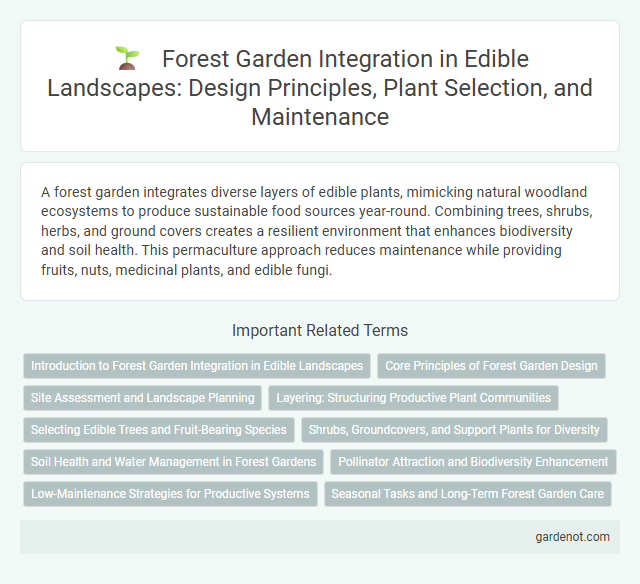A forest garden integrates diverse layers of edible plants, mimicking natural woodland ecosystems to produce sustainable food sources year-round. Combining trees, shrubs, herbs, and ground covers creates a resilient environment that enhances biodiversity and soil health. This permaculture approach reduces maintenance while providing fruits, nuts, medicinal plants, and edible fungi.
Introduction to Forest Garden Integration in Edible Landscapes
Forest gardens integrate diverse layers of perennial plants, including fruit and nut trees, shrubs, herbs, ground covers, and vines, creating a self-sustaining edible landscape. This agroforestry system mimics natural ecosystems, enhancing biodiversity, improving soil health, and providing year-round food production. Incorporating forest gardens into edible landscapes promotes resilience against climate fluctuations while reducing maintenance and external inputs.
Core Principles of Forest Garden Design
Forest garden design centers on mimicking natural forest ecosystems by integrating diverse layers, including canopy trees, shrubs, herbs, and ground covers to optimize space and productivity. Key principles emphasize biodiversity to enhance resilience, soil health through organic mulching, and water conservation using swales or contour planting. The system promotes perennial plants that require minimal maintenance while yielding continuous food, contributing to sustainable edible landscaping.
Site Assessment and Landscape Planning
Site assessment for a forest garden involves analyzing soil quality, sunlight exposure, drainage patterns, and microclimates to optimize plant growth and biodiversity. Landscape planning integrates permaculture principles, selecting native and drought-resistant edible species that enhance ecosystem services such as pollination and soil fertility. Strategic layering of canopy, shrub, and groundcover plants maximizes space efficiency and creates sustainable food production within the edible landscape.
Layering: Structuring Productive Plant Communities
Forest garden design maximizes productivity by layering plants in vertical strata, including canopy trees, understory trees, shrubs, herbs, groundcovers, vines, and root crops. This stratification mimics natural forest ecosystems, enhancing biodiversity, improving soil health, and optimizing sunlight use for each plant species. Layering promotes efficient space utilization, leading to sustainable yields of edible fruits, nuts, herbs, and vegetables throughout the year.
Selecting Edible Trees and Fruit-Bearing Species
Selecting edible trees and fruit-bearing species for a forest garden involves prioritizing native and climate-adapted varieties such as apple (Malus domestica), pear (Pyrus communis), and chestnut (Castanea sativa) to ensure sustainable growth and yield. Incorporating nitrogen-fixing trees like black locust (Robinia pseudoacacia) supports soil health while promoting biodiversity. Diversity in species selection enhances resilience against pests and diseases, while providing continuous harvests throughout the seasons.
Shrubs, Groundcovers, and Support Plants for Diversity
Shrubs such as elderberry and blueberry provide essential fruit yields while enhancing habitat complexity in a forest garden. Groundcovers like clover and creeping thyme suppress weeds, retain soil moisture, and improve nitrogen levels for healthier plants. Support species including dynamic accumulators like comfrey and nitrogen-fixing plants such as goumi berry promote nutrient cycling and overall ecosystem resilience.
Soil Health and Water Management in Forest Gardens
Forest gardens enhance soil health by integrating diverse perennial plants whose deep root systems improve soil structure, increase organic matter, and promote beneficial microbial activity. These gardens utilize mulching and groundcover plants to reduce soil erosion, maintain moisture levels, and suppress weeds, leading to sustainable water retention. Strategic layering of trees, shrubs, and herbaceous plants facilitates natural water cycling and minimizes runoff, optimizing water management within the ecosystem.
Pollinator Attraction and Biodiversity Enhancement
Forest gardens enhance biodiversity by creating layered plant structures that provide diverse habitats for pollinators such as bees, butterflies, and hummingbirds. The inclusion of flowering shrubs, fruit trees, and native plants ensures continuous nectar and pollen sources throughout the growing season. This rich plant diversity supports ecological balance and improves crop yields by attracting and sustaining essential pollinator populations.
Low-Maintenance Strategies for Productive Systems
Forest gardens utilize diverse, perennial plant layers such as canopy trees, shrubs, herbs, and ground covers to create self-sustaining ecosystems that demand minimal maintenance. Implementing nitrogen-fixing plants and mulching techniques enhances soil fertility and moisture retention, reducing the need for additional inputs. Incorporating polycultures and dynamic accumulators supports natural pest control and nutrient cycling, ensuring continuous productivity with low labor requirements.
Seasonal Tasks and Long-Term Forest Garden Care
Seasonal tasks in a forest garden include pruning, mulching, and planting cover crops to enhance soil fertility and plant health throughout spring and autumn. Long-term care involves monitoring biodiversity, managing pests naturally, and gradually introducing perennial species to create a self-sustaining ecosystem. Consistent observation and adaptive management ensure the forest garden thrives and supports diverse edible plants year-round.
Forest garden Infographic

 gardenot.com
gardenot.com